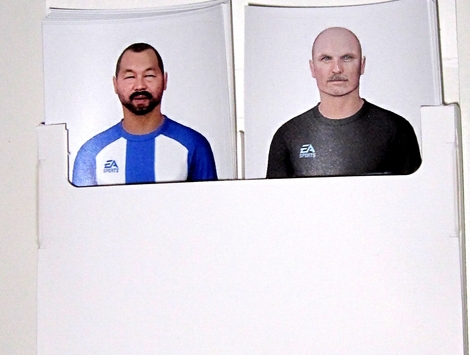Figurine is a set of virtual soccer players created with Electronic Arts’ GameFace technology by Coll.eo. GameFace is a customization tool available at easports.com and compatible with such videogames as FIFA Soccer, NHL Hockey, and John Madden Football. The depicted athletes in the series are digital replicas of internationally known contemporary artists. The project comprises “real” stickers measuring 84 x 55mm or 3.30 x 2.17", machinima (videos), screenshots, and C-Prints on archival paper. The series include: Matthew Barney, Ai Weiwei, Andreas Gursky, Douglas Gordon, Jeff Koons, Maurizio Cattelan, and many more.
Full Description
Stickers, videos, screenshots, and C-Prints on archival paper
Work metadata
- Year Created: 2012
- Submitted to ArtBase: Friday Dec 7th, 2012
- Original Url: http://colleo.org/project-description4/
-
Work Credits:
- colleo, primary creator
Take full advantage of the ArtBase by Becoming a Member
Artist Statement
Figurine is a set of virtual soccer players created with Electronic Arts’ GameFace technology by Coll.eo. GameFace is a customization tool available at easports.com and compatible with such videogames as FIFA Soccer, NHL Hockey, and John Madden Football. The depicted athletes in the series are digital replicas of internationally known contemporary artists. The project comprises “real” stickers measuring 84 x 55mm or 3.30 x 2.17", machinima (videos), screenshots, and C-Prints on archival paper. The series include: Matthew Barney, Ai Weiwei, Andreas Gursky, Douglas Gordon, Jeff Koons, Maurizio Cattelan, and many more.
The title is a double entendre. In English, it refers to a small ornamental figure or “statuette, especially one of a human form” (The Oxford Dictionary). The term originated from the Italian word figurina, diminutive of figura, which, in turn, derives from Latin figura.
In Italian, the term figurine (plural of figurina, and pronunced fee-goo-ree-neh) also means "statuette". However, in the vernacular it is inextricably associated with the football stickers produced by Panini, a company headquartered in Modena and named after the Panini Brothers, Giuseppe and Benito, who founded it in 1961. Panini is famous for their stickers and trading cards of professional athletes sold in newsstands all over the country. Their first and most successful product was the Calciatori/Football Players collection. According to a well known story - the company's mythopoesis - the Panini brothers were operating a newspaper distribution office downtown Modena since the 1950s and found a collection of figurine that a Milanese company was unable to sell. They acquired the collection and sold the figurine in packets of two for ten lire each. They commercialized more than three million packets. This unexpected success led Giuseppe to manufacture and sell his own figurine under the Panini brand in 1961. He was soon joined by his brother Benito. Panini sold more than fifteen million packets of figurine in 1961. The craze had just begun: the figure - no pun intended - almost doubled in 1962 as the company sold twenty nine million units. Figurine became objects of wide interest in Italy and acquired massive popularity among teenagers, who began collecting them and using them to create new games. In the 1970s, a technological innovation increased their appeal: Panini introduced a self-adhesive sticker, replacing the previous version requiring glue. The new series was launched with the "Stick with Panini" campaign, which was constantly played in a jingle especially created for TV commercials aired during shows aimed at younger audiences. Thanks to a clever marketing campaign, the figurine market boomed. Today, rare figurine can reach very high prices on the collectors' market. In 1992, the company was sold to American giant Marvel.
Figurine is also Coll.eo’s homage to Peter Davies’s “chart-paintings” such as “The Hot One Hundred” (1997) and “The Hip One Hundred” (1998) which, as critic and curator Patricia Ellis writes, expose the “Art world as insidious, cliquey, market-oriented as any entertainment medium [...] “Rating his friends, colleagues and art heroes, Davies pits artists and their works against each other in his mind, vying with each other for that coveted number-one spot.” (2003: 216).
In other words, the Figurine series suggests that Artworld and the world of professional soccer are not as different as one may think. They are both obsessed with figures, stats - mostly relating to the performers' compensation - style, and skills. Although they appeal to different audiences, they operate according to similar rules - Howard Becker (1982) would likely agree. For instance, it is not incidental that all the featured stars in this set are male. Although soccer is played by millions of women around the world, as of 2012, FIFA Soccer, the best selling soccer game in the history of the medium, does not contemplate female avatars. Similarly, women in the Artworld are still struggling to achieve the same level of recognition - including compensation equality - of their male counterparts.
Finally, the “collectible card format” of Figurine alludes to the role played by collectors in the Art World, whose role in making a certain kind of production “sticky” is crucial. After all, they gotta catch’em all.
Coll.eo is Colleen Flaherty and Matteo Bittanti
San Francisco, November 18 2012
Works cited
Becker Howard, Artworlds. Berkeley: University of California Press. 1982.
Ellis, Patricia, “The Hip One Hundred”, in 100 The Work That Changed British Art, London: Jonathan Cape. 2003.
Ellis, Patricia, “The Hot One Hundred”, Saatchi Gallery Online, 2007. URL





